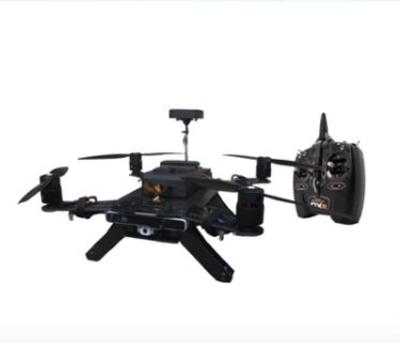Fri, Mar 03, 2017
Enters The Consumer Market In The $1,100 Range
Intel has introduced a read-to-fly drone it is calling the Intel Aero.

Intel's commercial drones made a splash at the Super Bowl by providing a light show behind Lady Gaga as she dropped into NRG Stadium for the halftime show, even if the display was pre-recorded.
Now, the company is offering to consumers a ready-to-fly unmanned aerial vehicle (UAV) development platform that is a fully assembled, fully functional quadcopter powered by the Intel Aero Compute Board, equipped with Intel RealSense depth and vision capabilities, running an open-source Linux operating system. It is geared for developers and researchers who desire a fast path to getting applications airborne.
The Intel Aero Ready To Fly Drone combines the Aero Compute Board and the Aero Vision Accessory Kit with the Aero Flight Controller, GPS, Compass, airframe, ESCs, motors, transmitter and receiver. The only thing needed to start flying is a charged battery. (recommended battery: Li-Po, 4S, 4000+ mAh, with XT60 connector)
The aircraft includes the Intel Aero Compute Board with an Atom x7-Z8750 processor.
Other features include:
- An 8MP RGB camera (front-facing) – one of the 3 camera modules included with the Aero Vision Accessory Kit
- VGA camera, global shutter, monochrome (down-facing)
- Open-source embedded Linux, Yocto Project
- Insyde Software InsydeH2O UEFI BIOS optimized for the Intel Aero Platform for UAVs. More about InsydeH20
- Intel RealSense camera (R200)
- Intel Aero Flight Controller with Dronecode PX4 autopilot
- STM32 microcontroller
- Temperature compensated: 6 DoF IMU, magnetometer, and altitude sensors
- Connected to the Aero Compute board over HSUART and communicates using MAVLink protocol
- Pre-assembled quadcopter
- Carbon fiber airframe
- GPS and compass
- Power distribution board
- 4 electronic speed controllers
- 4 motors
- 8 snap-on propellers
- Spektrum DSMX Serial Receiver
- Spektrum DXe Transmitter (2.4GHz DSMX)
The Intel Aero Ready to Fly Drone is a platform for developers and is intended to be modified by developers according to their professional judgment. Intel has not established operating limitations for this drone development platform, or tested any configurations other than the base configuration as shipped. Developers are responsible for testing and ensuring the safety of their own configurations, and establishing the operating limits of those configurations.
(Source: Intel website. Image from Intel YouTube video)
More News
Aero Linx: Model Aeronautical Association of Australia MAAA clubs are about fun flying, camaraderie and community. For over 75 years, the MAAA has been Australia’s largest fl>[...]
Touchdown Zone Lighting Two rows of transverse light bars located symmetrically about the runway centerline normally at 100 foot intervals. The basic system extends 3,000 feet alon>[...]
“Discovery and innovation are central to our mission at Virgin Galactic. We’re excited to build on our successful record of facilitating scientific experiments in subor>[...]
How To Get A Story On Aero-TV News/Feature Programming How do I submit a story idea or lead to Aero-TV? If you would like to submit a story idea or lead, please contact Jim Campbel>[...]
Student Pilot Reported That During Rotation, “All Of A Sudden The Back Of The Plane Kicked To The Right..." Analysis: The student pilot reported that during rotation, “>[...]
 ANN's Daily Aero-Linx (05.02.24)
ANN's Daily Aero-Linx (05.02.24) ANN's Daily Aero-Term (05.02.24): Touchdown Zone Lighting
ANN's Daily Aero-Term (05.02.24): Touchdown Zone Lighting Aero-News: Quote of the Day (05.02.24)
Aero-News: Quote of the Day (05.02.24) ANN FAQ: Contributing To Aero-TV
ANN FAQ: Contributing To Aero-TV NTSB Final Report: Cirrus Design Corp SR20
NTSB Final Report: Cirrus Design Corp SR20



